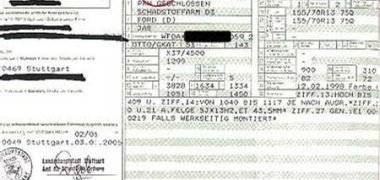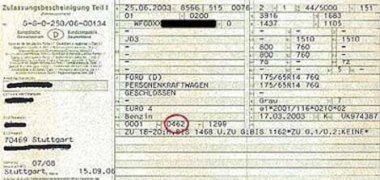Low emission vehicle labelling
Low emission vehicle labelling
The Ordinance on the Issuance and Amendment of Regulations on the Labelling of Low-Emission Motor Vehicles regulates the labelling of motor vehicles according to their pollutant group in a uniform manner throughout Germany. Passenger cars, commercial vehicles and buses from Euro 2 to Euro 4 (passenger cars) and Euro II to Euro V (trucks, buses) will be labelled according to the European limit value levels complied with by the vehicles.
If the vehicle is successfully retrofitted, motorists can achieve classification in a better pollutant group. When retrofitting diesel passenger cars with a particulate reduction system, the particulate reduction level (PM level) achieved is decisive. Diesel vehicles with emission standard Euro 1 or worse and vehicles with petrol engines without a regulated catalytic converter or a regulated catalytic converter of the first generation do not receive a sticker.
The regulations on the application of traffic restrictions - in particular the spatial and temporal scope of these restrictions, which pollutant groups are exempted, etc. - are the responsibility of the federal states. - are the responsibility of the federal states and are determined within the framework of clean air plans and action plans for conurbations. For a differentiated design of these restrictions, vehicles must be marked with stickers. Vehicles marked accordingly can be completely or partially exempted from possible traffic restrictions.
Further details of the labelling ordinance
Regulations on driving bans also affect foreign vehicles; they therefore also require stickers to indicate the pollutant class in order to be exempt from traffic bans. For this purpose, corresponding proof of compliance with the European exhaust emission standards from the home country must be submitted. If this is not possible, the classification is based on the year of first registration. For HGVs covered by the toll regulation, the evidence of pollutant emissions provided for in the HGV Toll Regulation can be used.
The stickers can be obtained from the registration authorities as well as from the bodies authorised to carry out exhaust emission tests, i.e. technical inspection associations and over 30,000 workshops. Two- or three-wheeled motor vehicles, mobile machinery and equipment, agricultural and forestry tractors and work machines are exempt from the traffic bans, even if they are not marked with a sticker. This also applies to vehicles for medical care or the transport of disabled persons (entry "aG", "H" or "Bl" in the severely disabled person's card),
as well as police, fire brigade and military vehicles. The directive provides that in "cases that cannot be postponed", vehicles can be exempted from the driving ban by the authorities or the police on site if this is in the public interest, in particular to supply the population with essential goods and services, or if "overriding interests of individuals that cannot be postponed so require", in particular to maintain manufacturing and production processes.
Where does the emission code number appear in the vehicle documents?
For vehicle documents issued before 1 October 2005:
(circled number field, under "Key number to 1")
The last two digits of the rounded number are decisive. In this case, the emission
key number is "30". Since it is a petrol vehicle (passenger car), this car
would be classified in pollutant group 4 according to the table and receive a green sticker.
For vehicle documents issued after 1 October 2005:
(here the key number is in line 14, under 14.1)
The last two digits of the rounded number are decisive. In this case, the emission
key number is "62". Since it is a petrol vehicle (passenger car), this car
would be classified in pollutant group 4 according to the table and receive a green sticker.
Frequently asked questions
Uncertainty reigns among Germany's motorists. Rumours are circulating about rigorous clean air laws, about bans from city centres, about a drastic decline in the value of older cars. Terms such as particulate matter, driving bans, low emission zones or soot particle filters are doing the rounds and are spiced with all kinds of half-knowledge. The ADAC clarifies and answers all questions on the subject of the sticker regulation.
What is the legal situation?
The EU has issued a directive to improve air quality, according to which air pollution with fine dust may only exceed a limit value (50 micrograms per cubic metre of air) on a maximum of 35 days a year. In order to be able to impose driving bans, the federal government passed the "Ordinance on the Identification of Low-Emission Motor Vehicles" (Sticker Ordinance) in May 2006. This came into force on 1 March 2007. It regulates the nationwide marking of passenger cars, trucks and buses with stickers according to pollutant group.
What is fine dust?
Fine dust is invisible to the naked eye; its particles have a diameter of less than ten micrometres (thousandths of a millimetre). It can be of natural origin, but is also released in industry or private households. In road traffic, particulate matter is produced by tyre abrasion, whirled-up dust and exhaust fumes - especially from unfiltered diesel vehicles. Fine dust particles cannot be filtered by the body and can penetrate into the alveoli of the lungs. Possible consequences: Respiratory diseases, heart and circulatory diseases.
Who is allowed to designate no-trespass zones?
The federal states must draw up clean air plans, which may also be used to order local traffic restrictions. On the basis of these plans, the municipalities can then determine exactly which roads or regions may be driven on and to what extent. Areas with high levels of fine dust pollution can be declared - temporarily or permanently - as "environmental zones" in which driving bans apply to certain cars.
Which vehicles are affected?
Driving bans in "environmental zones" initially affect mainly cars with higher pollutant emissions that do not receive a sticker: Diesel vehicles with Euro1 emissions standard and worse (built before the mid-1990s) and petrol vehicles without a regulated catalytic converter (before the early 1990s), but also (older) catalytic converter vehicles. Motorbikes, three-wheeled vehicles, agricultural tractors, police and fire brigade vehicles and ambulances are generally exempt from the ban.
Are there also exemptions for residents or classic cars?
Not according to federal regulations. Whether there will nevertheless be regulations in their favour is still disputed and depends on the state environment ministries, which have the "sovereignty" here. So there will be different regulations in affected cities. Transitional periods are also being discussed in order to cushion hardship for tradespeople and residents. The ADAC demands that the principle of proportionality be observed, according to which measures are inadmissible that lead to severe restrictions on individuals without achieving significant improvements. Accordingly, residents should not be locked out of their homes and classic cars whose contribution to air pollution is very small should not be subject to driving bans.
How are prohibited zones recognisable?
The environmental zones are marked with signs. An additional sign shows the sticker colours required for access. By the way: cars and trucks from abroad also need a sticker if they are to drive in prohibited zones.
What are the costs of infringements?
Anyone who enters a prohibited zone without a sticker must expect a fine of 40 euros and a point in Flensburg. Important: There is no general obligation to display a sticker. Only those who actually want to drive in an "environmental zone" need the sticker.
Where can I get the badges and how much do they cost?
The stickers are available at the registration authorities and everywhere where the exhaust emission test (AU) can be carried out - the fee is five euros in the Waldeck-Frankenberg district. In the opinion of the ADAC, however, the stickers should be given and sent free of charge so as not to "punish" owners of clean vehicles.
Where do they need to be fitted on the vehicle?
Clearly visible on the inside of the windscreen. By the way: The old "G-Kat" stickers are no longer needed since the expiry of the Ozone Act at the end of 1999.
What applies to gas vehicles?
They have a petrol engine, the same regulations apply as for petrol engines.
What applies to tourists?
Just like German car owners, they have to get a sticker if they want to drive in low emission zones - by the way, driving bans abroad also apply to German tourists.
